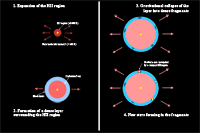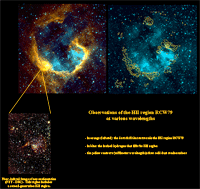A&A press release: How do massive stars form?... (8 November 2005)
- Details
- Published on 08 November 2005
A&A press release
Released on November 8th, 2005
|
How do massive stars form? - A case of triggered high-mass star formation |
Based on the article “Triggered massive-star formation on the borders of Galactic HII regions. II. Evidence for the collect and collapse process around RCW 79", by Zavagno et al.
(Published in Astronomy & Astrophysics. )
In this framework, the team led by Annie Zavagno and Lise Deharveng (from the Laboratoire d’Astrophysique de Marseille, France) selected regions where several generations of massive stars are likely to be formed. Stars more massive than 8 solar masses, once formed, emit intense UV photons that ionize the surrounding gas. The region filled with ionized hydrogen is called an HII region. Theory suggests that the expansion of the HII region can trigger massive star formation: after the HII region has formed, it expands continuously because the temperature inside the region is much higher than in the cold environment that surrounds it. During the expansion, a dense layer of gas and dust is collected around the HII region, after which gravitational instabilities in the layer cause it to fragment into dense clumps, which then go on to collapse into new stars. The fragments are massive and thus form massive objects (stars or clusters). The successive steps of this process, called collect and collapse process, are shown in Figure 1.
 Fig. 1 - The collect and collapse process: a way of triggering the formation of massive stars.
Fig. 1 - The collect and collapse process: a way of triggering the formation of massive stars.
To characterize this process, the team selected the Galactic HII region RCW 79, located 14000 light-years from the Earth. They combined observational data obtained at different wavelengths, as well as from various origins (space, ground-based telescopes, and archived observations), to probe different parts of the region, as illustrated in Figure 2.
 Fig. 2 - Observations of the HII region RCW 79 at various wavelengths.
Fig. 2 - Observations of the HII region RCW 79 at various wavelengths.
The locations of all the structures that were picked out at various wavelengths agree very well with the predictions of the collect and collapse process. The conclusions drawn by the team largely rely on the morphological relations between these structures. The combined picture of RCW 79 they obtained is therefore a straightforward illustration of the triggered massive-star formation process that now occurs in this region. These observations show that the collect and collapse process is the main triggering agent of massive star formation observed on the borders of this region.
Triggered massive-star formation on the borders of Galactic HII regions. II. Evidence for the collect and collapse process around RCW 79
by A. Zavagno, L. Deharveng, F. Comeron, J. Brand, F. Massy, J. Caplan, and D. Russeil.
Contact persons:
- Science:
Dr. Annie Zavagno
Laboratoire d'Astrophysique de Marseille
2, place Le Verrier
13248 Marseille, Cedex 4
Phone: +33 (0)4 95 04 41 55 - Email: This email address is being protected from spambots. You need JavaScript enabled to view it.
- Press office:
Dr. Jennifer Martin
Journal Astronomy & Astrophysics
61, avenue de l'Observatoire
75014 Paris, France
Phone: +33 1 43 29 05 41 - Email: This email address is being protected from spambots. You need JavaScript enabled to view it.
© Astronomy & Astrophysics 2005


